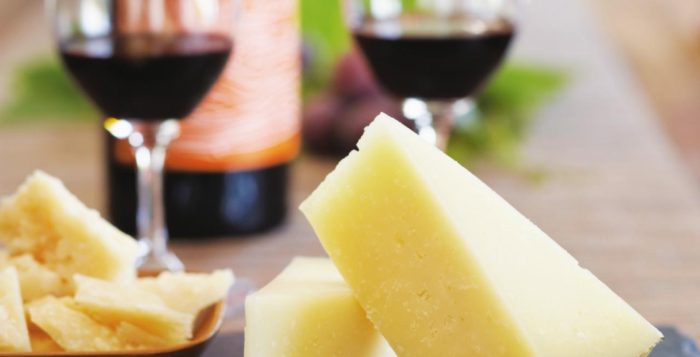By Bob Lipinski
“The only way to learn about cheese is to eat it.” (Ernest Oldmeadow, English Gastronome)
Monterey Jack, a cow’s milk cheese, was developed in the 1880s in Monterey by a Scot merchant named David Jacks. He derived the name, “Monterey Jack,” from the shipping point, Monterey, California, and his last name, Jacks, minus the “s.” There are, however, several other versions as to the origin of Monterey Jack cheese as well.
Dry Jack cheese is Monterey Jack that has been aged 6 to 9 months or longer. It came into existence during World War I, when San Francisco cheese wholesaler, D.F. DeBernardi, found his Monterey Jack cheese had aged too long and “gone hard.” Italian immigrants found it useful because it could be grated like Parmigiano-Reggiano or pecorino.
Although the cheese was first developed and sold in Monterey, it’s now produced in several other states and with variations from dairy to dairy. Most Monterey Jack has an inedible rind, often black in color and is sometimes coated with a mixture of oil, pepper, and cocoa. The cheese generally has a pale yellow-orange interior with numerous small holes. It is rectangular or wheel shaped, depending on the preference of the dairy.
The cheese has a sweet, nutty flavor with a tart aftertaste, similar to cheddar. When old, the taste becomes sharp and tangy. It is sometimes flavored with caraway seeds, dill, fennel, or jalapeño peppers. It has a semihard texture and when labeled “Dry Jack,” it is a hard, tangy cheese suitable for grating.

Dry Jack Cheese
Monterey Jack is also called Sonoma Jack (brand name), California Jack or Jack.
The cheese can be paired with many wines, including red, white, rosé, sparkling, port, and some sherries. A few wines I recently tasted would pair well with a wedge of Monterey Jack. My tasting notes follow:
2022 Root: 1. Cabernet Sauvignon, Maipo Valley, Chile. 100% sustainable. (Blend of Cabernet Sauvignon and Syrah). Aged in a combination of French and American oak. Rich regal color with a nose full of dark berries, moss, and vanilla. Flavors of blackberries, plum, mint, black olives, and roasted coffee. Try it with a leg of lamb rubbed with mint and rosemary.
2022 Root: 1. Sauvignon Blanc, Casablanca Valley, Chile. 100% sustainable. Aged in stainless steel. Delightful aroma of citrus, hay, pear, and fennel. Flavor of pineapple and nectarine with hints of lemongrass. A good pairing would be Sauerbraten with a sweet-sour gravy (usually made with ginger snaps), dumplings, and red cabbage.
2022 Attems Pinot Grigio “Ramato,” Friuli-Venezia Giulia, Italy. (Ramato refers to the Italian word rame, which translates to copper) Copper-colored because the juice was fermented in contact with “pink-colored” the grape skins, causing greater depth of color and flavor. Floral bouquet of exotic fruits, rose petals, and green apple. Flavors of peach, bitter cherry, melon, and citrus, with mineral sensations. The wine pairs well with prosciutto wrapped figs.
2022 Duca Di Salaparuta “Calanica” Grillo DOC Sicily, Italy. Pale yellow color with a scented aroma of fresh flowers, honeysuckle, and apples. Dry with flavors of passion fruit, pineapple, and bitter orange. A pleasing aftertaste of almonds. Pair it with grilled swordfish cooked with tomatoes, pine nuts, raisins.
2021 Sentiero del Vento Vermentino “Terre Siciliane IGT,” Sicily, Italy. Straw yellow in color with pea-green highlights. An aroma and flavor of melon, pears, lemon, and citrus, with hints of chamomile, fennel, thyme, and wildflowers. I enjoyed it with arancini di riso (fried rice balls with cheese, peas, chopped meats, tomatoes).
Bob Lipinski is the author of 10 books, including “101: Everything You Need To Know About Whiskey” and “Italian Wine & Cheese Made Simple” (available on Amazon.com). He conducts training seminars on Wine, Spirits, and Food and is available for speaking engagements. He can be reached at www.boblipinski.com OR bkjm@hotmail.com


 Bob Lipinski, author of 10 books; writes, consults, and conducts training seminars on Wine, Spirits, and Food and is available for speaking engagements.
Bob Lipinski, author of 10 books; writes, consults, and conducts training seminars on Wine, Spirits, and Food and is available for speaking engagements.
Thank you, Bob!